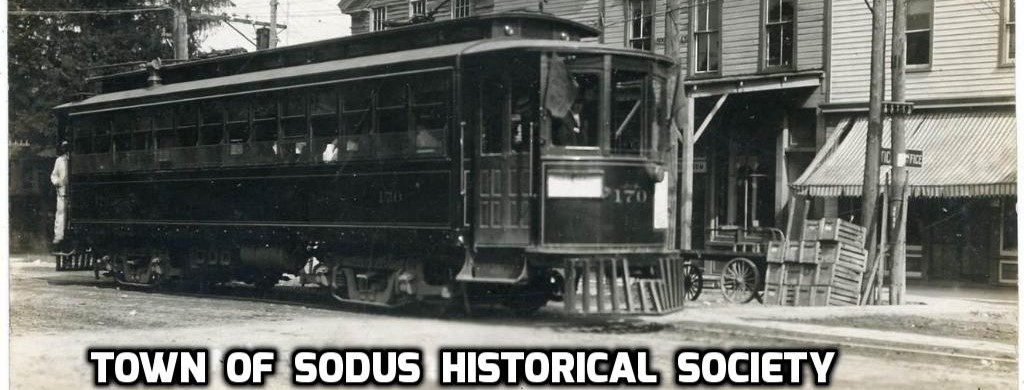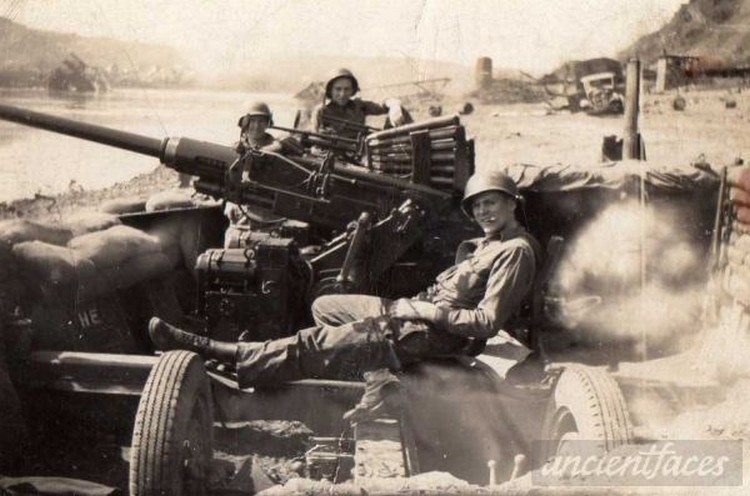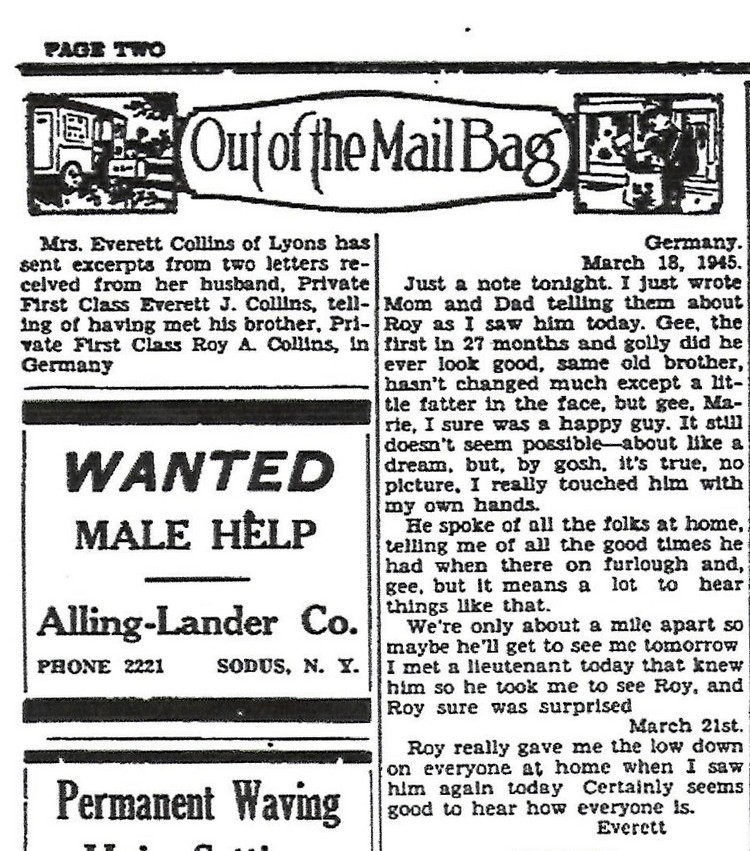Music Band of Brothers from the HBO hit TV series “Band of Brothers”
From this day to the ending of the world,
But we in it shall be rememberèd-
We few, we happy few, we band of brothers;
from William Shakespeare’s play, Henry V, in Act IV Scene iii 18–67.
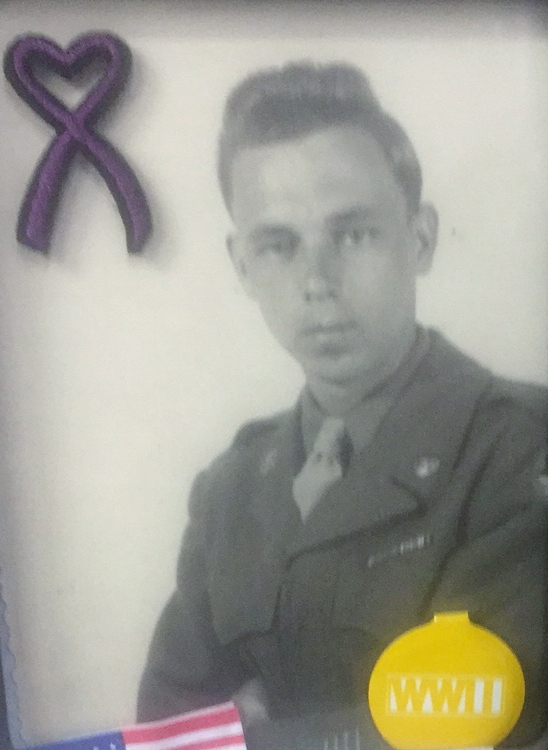
Young Everett Collins as a new army recruit circa 1943. Photo Courtesy of Lonnie Collins
The Collins family did their patriotic duty and sent four brothers to fight in the U.S. Army during World War II. Wallace (aka “Tommy”), Clayton, Everett and Roy Collins all went in harm’s way and suffered injuries but ultimately made it back home alive. Wallace fought in the China/Burma theatre of the war whereas Clayton, Everett and Roy fought in Europe. As was the practice at that time, the brothers were all placed in different units to reduce the risk of a family losing all of their sons.
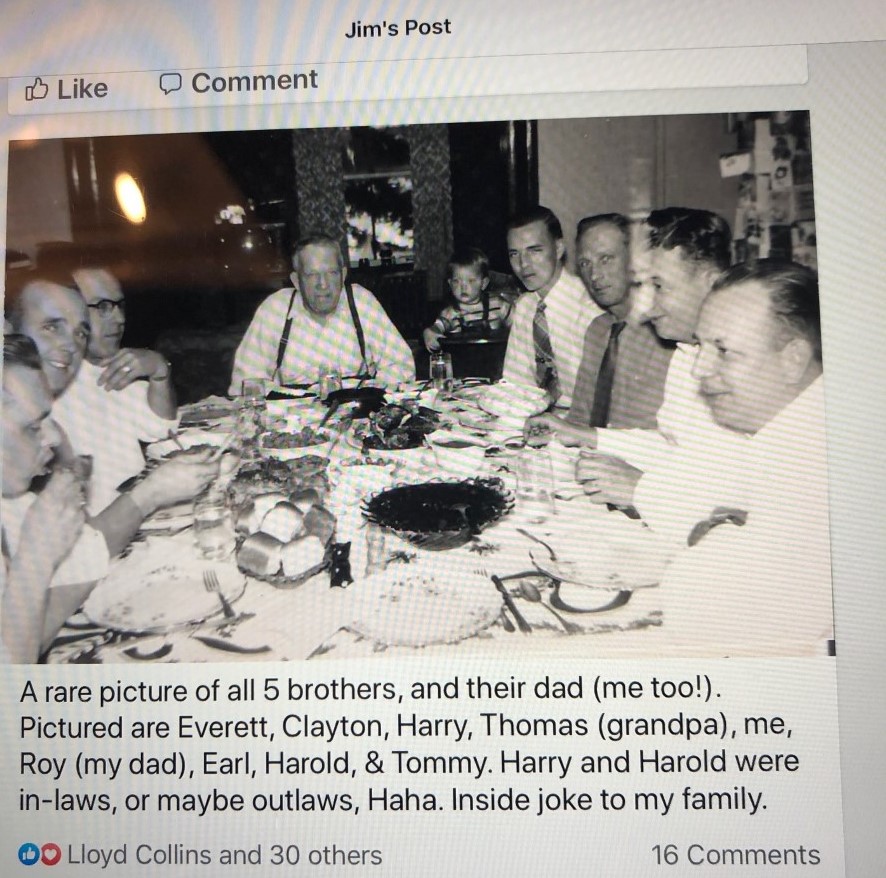
Photo of the Collins brothers taken in the early 1950s. From Roy’s son Jim.

Our Hometown Heroes banner by Lonnie and Sue Collins. Photo by Edie Farrington
This is the story of two of those brothers from Alton NY who went to war separately and would, by the most unlikely coincidence, meet at a pivotal moment during World War II.
The older of the two brothers was Everett J. Collins born on October 27, 1922. He grew up in Alton and enlisted in the Army in February 4, 1943 in Rochester. Initially a private in the 746th Tank Battalion, 9th Infantry, he eventually became a TEC 5 or Technician Fifth Class (the equivalent of a corporal) at the end of the war. Many of the photos and much of the information come from his son Lonnie. Lonnie got his name from his father’s WW II buddy named Lonnie. As his father and Lonnie were waiting to go ashore on the Normandy Beach (Utah) in the second wave, they made a pact to name their first born son after each other if they survived. Hopefully, somewhere out there now is a man named Everett.

Photo of Everett’s son Lonnie by Bruce Farrington
The younger brother was Roy A. Collins born May 16, 1925. He enlisted in Rochester in the Army on June 15, 1943 having become 18 years old. Roy was a PFC in the 581st which was an anti-aircraft Artillery Battalion.
Little did either of these two brothers know that their two units would cross paths at a pivotal battle in the Allied invasion of Europe.
Historians recognize three significant moments in the Allies’ war in Europe: The Invasion of Normandy, the Battle of the Bulge and the “Miracle at Remagen” (also known as the Battle of Remagen for the Ludendorff Bridge over the Rhine River). Our story concerns a chance encounter during the latter.
A detailed account of the battle can be found at:
https://en.wikipedia.org/wiki/Battle_of_Remagen
First a brief review of the Battle of Remagen for those who did not live through the horror of World War II. Having repulsed what would be Germany’s last offensive action on the western front at the Battle of the Bulge, the Allies were sweeping forward on a broad front toward Germany’s last line of defense which was the Rhine River separating Germany from France. Crossing the Rhine was crucial to taking the war into the heartland of Germany and putting an end to the Nazis’ ability to wage war. There was a number of bridges over the Rhine but every time the allies approached one (preceded by Allied artillery shelling), the Nazis would set off demolition charges and drop the bridge into the Rhine. By March 7th, 1945, the Allies believed all bridges had been destroyed and were no longer even looking to cross them and orders had been given accordingly. It was estimated that this would prolong the war by at least 2 weeks while a pontoon bridge could be constructed somewhere on the river to continue the push into Germany.
When elements of the 9th Armored Division (supported by the 9th Infantry Division) discovered an intact railroad bridge at the village of Remagen, the commander decided to risk court marshal by disobeying orders and attempt to take the bridge intact. The battle lasted from March 7 – 25 1945. A small (but ever increasing) group of infantry and tanks made it across the bridge and created a bridgehead on the German side. The Germans realizing the severity of the threat attacked it with everything they could.
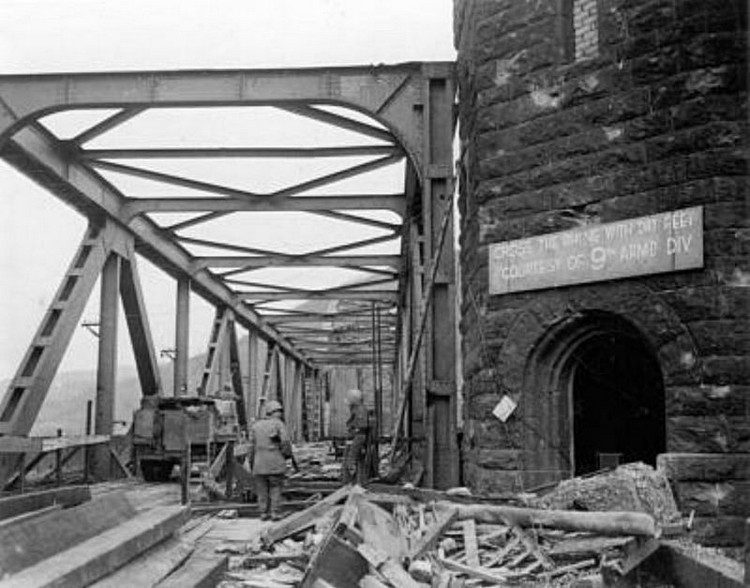
The Ludendorff Bridge. Photo courtesy of Wikipedia
These initially included several attempts to set off pre-placed demolition charges, Panzer tank attacks, artillery shelling and Infantry counter attacks but nothing worked against the determined American defenders. In desperation, the Germans attempted (for the first time) launching V2 rockets at targets inside Germany, new turbo jet bombers, existing Ju 87D dive-bombers and twin-engine Junkers Ju 88s and even using frogmen as demolition teams. The bridge endured aircraft bombing, direct artillery hits, near misses, and deliberate demolition attempts.
To protect the bridge against aircraft, the Americans positioned the largest concentration of anti-aircraft weapons during World War II leading to “the greatest antiaircraft artillery battles in American history.” The Americans counted 367 different German Luftwaffe aircraft attacking the bridge over the next 10 days. The Americans claimed to have shot down nearly 30% of the aircraft dispatched against them. The German air offensive failed.
The 581st anti-aircraft Artillery Battalion at Remagen. The Ludendorff bridge can be seen in the background. Photo from AncientFaces.com
It finally collapsed at 3:00 pm on 17 March. But by then U.S. Army combat engineers had finished building a tactical steel treadway bridge and a heavy duty pontoon bridge followed by a Bailey Bridge across the Rhine. Over 25,000 troops crossed into Germany before the Americans broke out of the bridgehead on 25 March 1945.
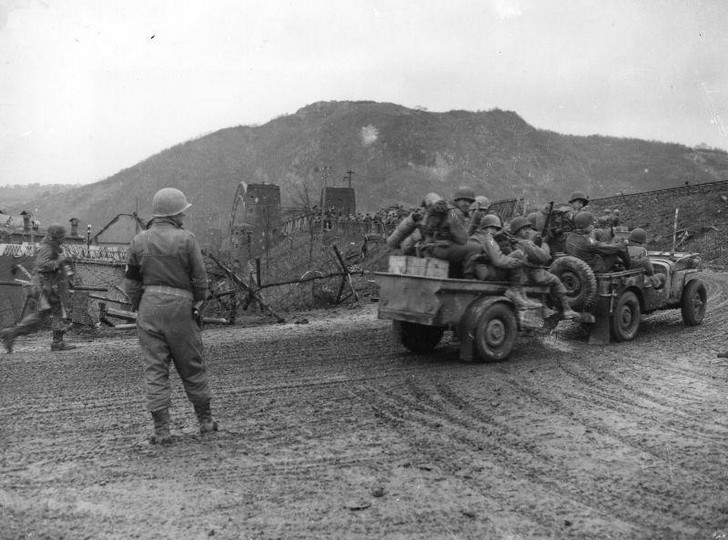
The 9th Infantry crossing the Ludendorff bridge at the village of Remagen. Photo courtesy of Wikipedia
Now the stage is set for the story of two brothers separated for over two years of war. As part of the 9th Infantry Division, Private Everett Collins is crossing the Ludendorff Bridge. He must be scared. The Germans still hold the high ground on the ridge overlooking the Village of Remagen on the German side which is occupied by both infantry and Panzer tanks. MPs directing traffic on the bridge are being routinely shot and being constantly replaced. Air attacks by German conventional and new turbojet and other aircrafts are going on and being driven off by fierce American anti-aircraft fire. He finally gets to the other side and learns his brother’s unit is only a mile away and runs into a lieutenant that knows his brother! We pick up the story from two letters he wrote home and were published in the The Record (Sodus) on April 5, 1945.
A picture is worth a thousand words…..
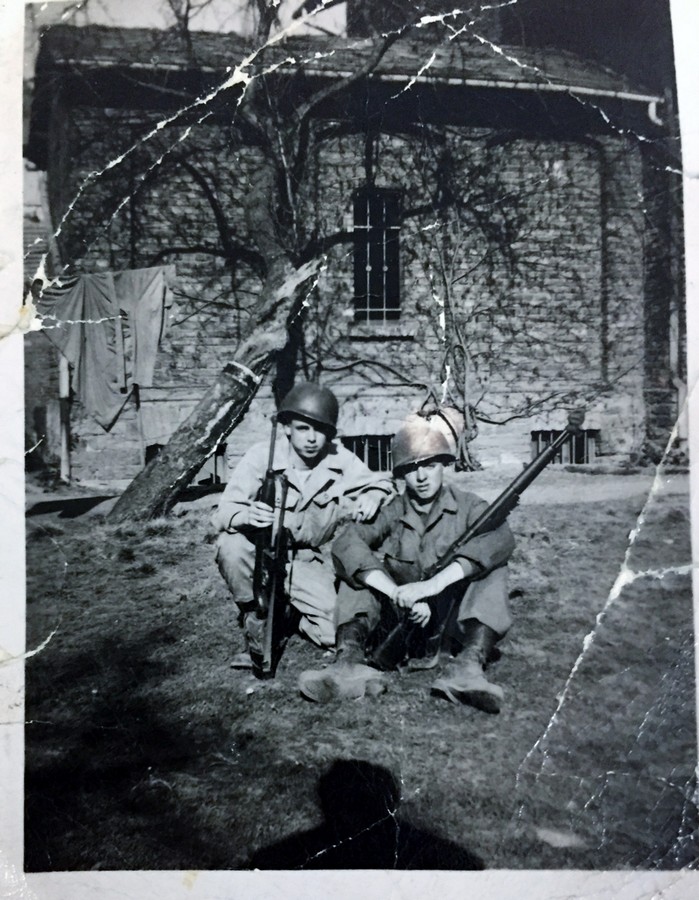
Everett Collin (left) with his younger brother Roy (right) near the Ludendorff Bridge near Remagen. March 1945. Photo courtesy of Lonnie Collins.
Lonnie tells me that Clayton would see a concentration camp after the German troops had abandoned it and the ovens were still warm to the touch with the bodies stacked like cord wood. When they got back home, they didn’t like to talk about the war years. That is very understandable but we should never forget the sacrifices of this brave band of brothers who were part of the greatest generation.
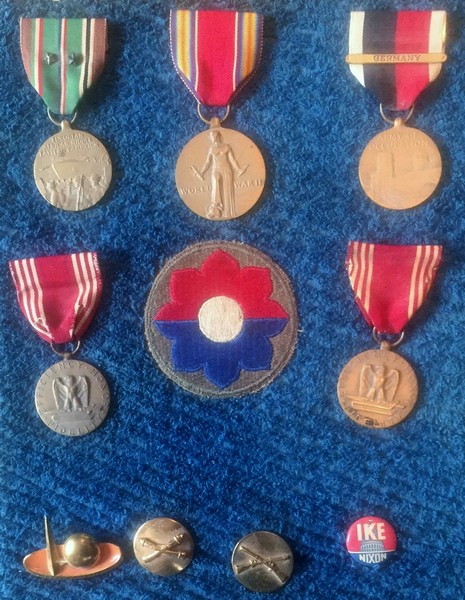
Everett Collins World War II medals. Photo courtesy of Lonnie Collins.
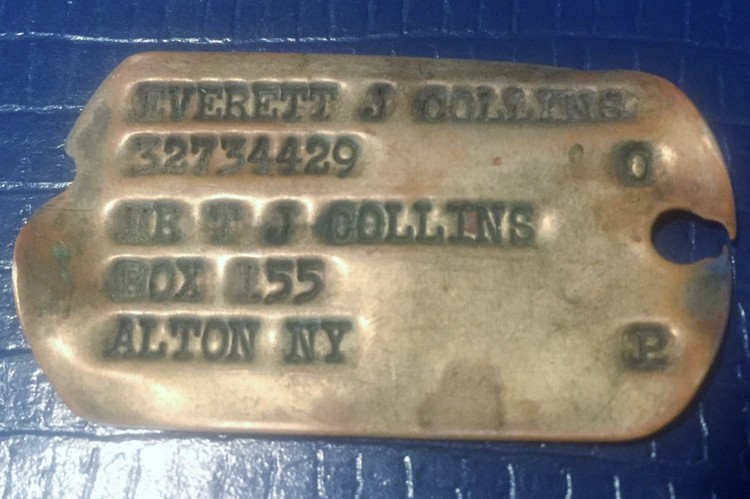
In memory of Everett J. Collins. 10/27/1922 – 5/27/1993. Photo Courtesy of Lonnie Collins
Written by Bruce Farrington, August 2017
